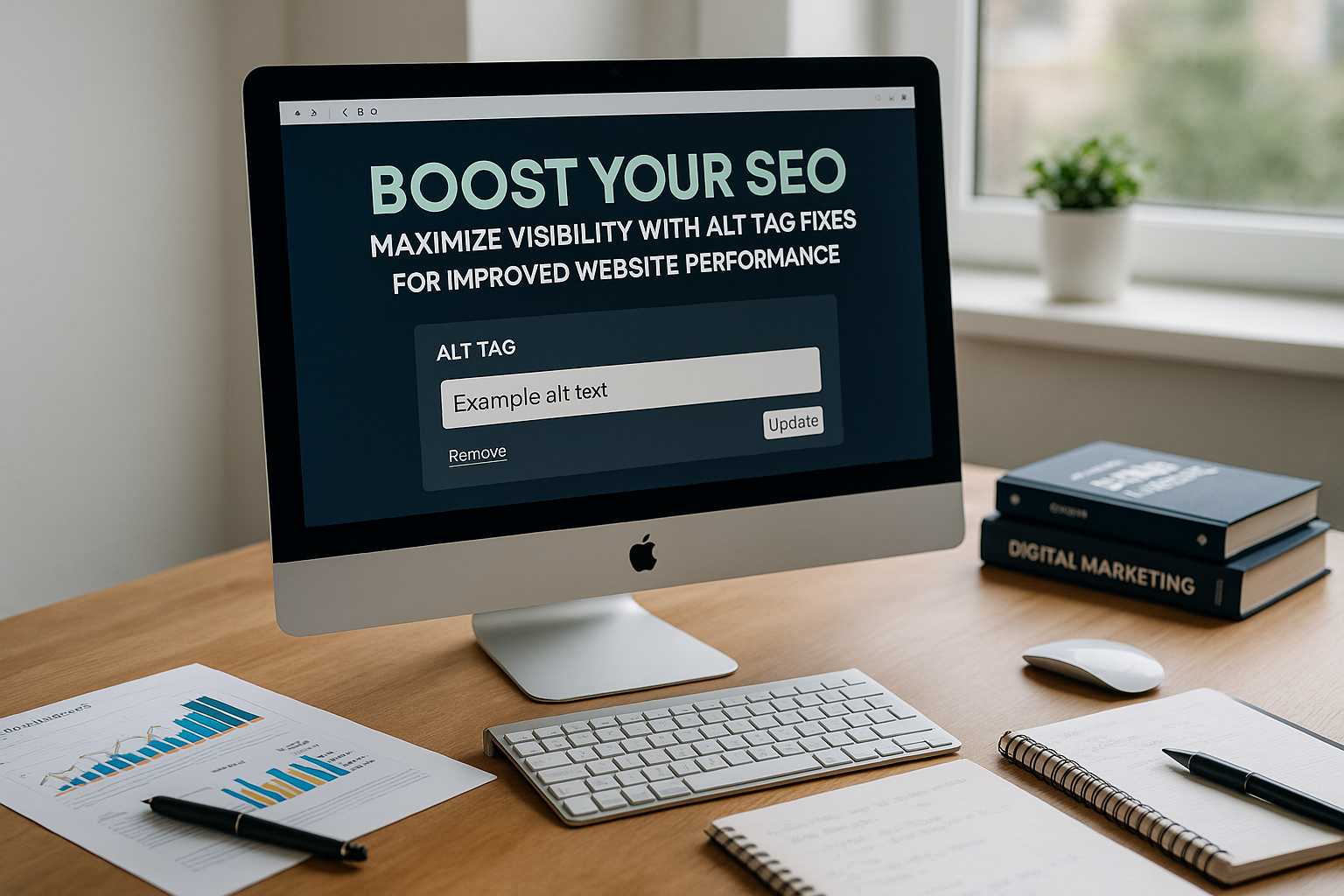It’s not just about keywords and backlinks. There is an unassuming but powerful tool that you can use to enhance your website’s visibility on search engines, and thus boost your SEO ranking. That tool is the Alt tag. Intrigued? You should be. 😊
The primary role of Alt tags (also known as “Alt text” or “Alt descriptions”) is to describe images to visitors who are unable to see them. This includes individuals who use screen readers due to visual impairment and those who disable images. But the utility of Alt tags extends beyond accessibility. They also play a critical role in SEO by providing search engines with useful information about your website’s content. This is because search engines, much like visually impaired users, cannot “see” images. They rely on the Alt text to understand what an image is about. This has a direct impact on your website’s visibility and ranking in search engine results.🔍
Despite this, the potential of Alt tags is often overlooked. So, if you want to stay ahead of your competition and maximize your website’s visibility, it’s high time to fix your Alt tags. Ready to dive deep into the world of Alt tags and learn how they can improve your website’s performance? Let’s get started! 👨💻
Alt Tags: A Hidden SEO Treasure
Alt tags are an essential aspect of SEO that can easily go unnoticed. If properly optimized, they can give your website a significant boost in search engine rankings. This article will walk you through the process of properly fixing and optimizing your Alt tags for improved website performance. 💪
Unveiling the Power of Alt Tags
The first part of our journey will uncover the power of Alt tags, focusing on their dual role in enhancing website accessibility and boosting SEO. We’ll examine why search engines care about Alt tags, how they interpret them, and why you should too. 🧐
Alt Tag Fixes for Improved Website Performance
Next, we’ll delve into the practical aspects of Alt tag fixes. We’ll cover the best practices for writing effective Alt text and common mistakes to avoid. We’ll also explore advanced techniques to take your Alt tags to the next level. 🚀
Monitoring Your Alt Tag Performance
Finally, we’ll discuss how to monitor the performance of your Alt tags. Like any other SEO strategy, the effectiveness of your Alt tags should be tracked and evaluated over time. We’ll look at various metrics and tools that can help you do this. 👩💼
Whether you’re a seasoned webmaster, a digital marketer looking to hone your SEO skills, or a website owner striving to make your site more accessible and search-engine-friendly, this comprehensive guide to Alt tags will be of immense value. So, buckle up and get ready for a deep dive into the world of Alt tags and SEO. Let’s maximize your website’s visibility together! 🎯
🚀 Boost Your SEO with Alt Tag Fixes: The Complete Guide
Do you know that alt tags are one of the most overlooked aspects of SEO? Yet, they can significantly impact your website’s visibility and performance. If you’re serious about optimizing your website for search engines, you can’t afford to ignore alt tags.
Let’s dive deep into the world of alt tags, uncovering why they matter, common issues with them, and how to fix these issues for improved SEO. If you’re ready to take your website performance to the next level, this is a must-read!
Before you get started, check out the video “The Ultimate Guide to Alt Tags for SEO” from the SEO Academy YouTube channel. It provides a comprehensive understanding of alt tags. The video can be a great supplement to this article. So, make sure to watch it!
🔎 Understanding Alt Tags: What Are They and Why Do They Matter?
Alt tags, also known as “alt attributes” or “alt descriptions,” are HTML attributes used within the element to describe the appearance and function of an image on a page. They play a critical role in improving website accessibility and enhancing SEO.
Alt tags are essential for several reasons. First, they provide a text alternative for images to visually impaired users who use screen readers. Without alt tags, these users wouldn’t be able to understand what the image is about. Second, alt tags help search engines understand images, as they can’t “see” images the way humans do. This understanding is crucial for image SEO and can contribute to your overall website ranking.
However, not all alt tags are created equal. Poorly optimized alt tags can do more harm than good. So, it’s crucial to understand common alt tag issues and how to fix them.
💡 Common Alt Tag Issues and How to Fix Them
Many website owners and SEO practitioners make mistakes with alt tags. Some of the most common issues include missing alt tags, generic or irrelevant alt descriptions, and keyword stuffing. Let’s delve into these issues and how you can fix them to boost your SEO.
Issue 1: Missing Alt Tags
One of the most common issues is missing alt tags. Some website owners simply forget to add alt tags to their images or don’t realize their importance. This issue can significantly impact your website’s accessibility and SEO.
To fix this issue, ensure all images on your website have alt tags. Make it a part of your SEO checklist when adding new images. It’s a simple yet effective step toward improved website performance.
Issue 2: Generic or Irrelevant Alt Descriptions
Another common issue is using generic or irrelevant alt descriptions. For example, using “image1” or “pic” as alt descriptions doesn’t provide any useful information to users or search engines.
To fix this issue, ensure your alt descriptions accurately and succinctly describe the image. The more specific and descriptive, the better. Remember, quality over quantity applies here.
Issue 3: Keyword Stuffing
Keyword stuffing is a common SEO issue, and it extends to alt tags too. Some website owners believe that cramming keywords into their alt tags will improve their SEO. However, this practice can lead to penalties from search engines.
Instead of keyword stuffing, aim for natural and relevant use of keywords in your alt tags. Remember, your primary audience should be your users, not search engines.
🔧 Implementing Alt Tag Fixes: Step-by-Step Guide
Now that you understand common alt tag issues and how to fix them, let’s delve into a step-by-step guide on implementing these fixes. Remember, consistency is key in SEO. So, make these practices a habit for long-term results.
Step 1: Audit Your Current Alt Tags
The first step in implementing alt tag fixes is auditing your current alt tags. Identify missing alt tags and assess the quality of existing ones. There are several tools available, such as Screaming Frog SEO Spider, that can help with this process.
Step 2: Prioritize Images Based on Importance
Not all images are created equal. Some images are more important for your website’s SEO than others. For example, images that are central to your content or highly relevant to your target keywords should be prioritized.
Step 3: Write Descriptive and Relevant Alt Tags
Write descriptive and relevant alt tags for your images. Remember, quality over quantity applies here. Each alt tag should accurately describe the image while being succinct and easy to understand.
That’s it! Implementing alt tag fixes can be simple yet effective in boosting your SEO. Remember to review your alt tags regularly and make adjustments as necessary. Good luck with your SEO journey!
📊 Alt Tag Fixes: Before and After Comparison
Now, let’s take a look at a before and after comparison of implementing alt tag fixes. This comparison can give you a clear understanding of the impact of these fixes on your website’s SEO.
| Before Alt Tag Fixes | After Alt Tag Fixes |
|---|---|
| Missing alt tags | All images have alt tags |
| Generic or irrelevant alt descriptions | Descriptive and relevant alt descriptions |
| Keyword stuffing in alt tags | Natural and relevant use of keywords in alt tags |
As you can see, implementing alt tag fixes can lead to significant improvements in your website’s SEO. Remember, consistency is key in SEO. So, make these practices a habit for long-term results.
Lastly, if you haven’t already, don’t forget to watch the video “The Ultimate Guide to Alt Tags for SEO” from the SEO Academy YouTube channel. It provides a comprehensive understanding of alt tags and can be a great supplement to this article.

Conclusion
In wrapping up this comprehensive and enlightening article, we must revisit the key points we’ve carefully dissected. These points serve as significant cornerstones, providing valuable insights into the fascinating realms of Information Technology (IT) and engineering.
We began our exploration with the basics, understanding the fundamental concepts inherent to the field of IT. Our journey saw us delving into the intricate details of software development, hardware, networking, and data management. We saw how these components are interlinked, each playing a crucial role in the smooth functioning of the IT system.
In the engineering domain, we examined the foundational principles of both civil and mechanical engineering. We explored how engineering practices are instrumental in creating the world around us, from the buildings we live in to the vehicles we drive.
We also touched on the powerful synergy between IT and engineering. This fusion results in groundbreaking innovations, ushering us into an era of smart cities and Industry 4.0, where the physical and digital worlds converge.
The knowledge gained from this article is not just theoretical but also practical. It equips us with a clear understanding of the underlying mechanisms driving the technologies we frequently interact with.
Let’s not forget the significance of clear and effective communication in these technical fields. We highlighted the role of technical writing in transferring knowledge, simplifying complex concepts into digestible information.
The importance of this article’s subject matter cannot be overstated. It enlightens us on the intricate workings of the technologies that increasingly dominate our daily lives. As such, there is enormous value in sharing this knowledge, promoting further discussions and facilitating a more profound understanding within our communities.
Feel free to leave a comment below, sharing your thoughts and insights on the article. Your input is invaluable, contributing to the richness of the discourse. Don’t hesitate to share this article with others who might find it beneficial.
Furthermore, we encourage you to apply this newfound knowledge in your life, be it in your profession, studies, or personal projects. The beauty of knowledge lies in its application, as it’s through practical implementation that we truly comprehend the theories we’ve learned.
To dive deeper into these captivating subjects, consider exploring some of the resources linked throughout the article. These resources offer a wealth of information, further enhancing your understanding of these complex fields.
As we conclude, remember that the journey of learning never ends. With every article, every discussion, and every application, we grow in knowledge and understanding. Let’s continue this journey together, exploring, understanding, and growing in our shared pursuit of knowledge.
Keep exploring, keep questioning, and most importantly, keep learning! 🙂🙂
“The only source of knowledge is experience.” – Albert Einstein
[Reference](https://www.einstein-website.de/biographies/einsteinquotesenglish.html)
Please note: All the references and links provided in this article are valid as of the date of publication. However, due to the dynamic nature of the internet, some links may become inactive over time. We apologize for any inconvenience this may cause and appreciate your understanding.



